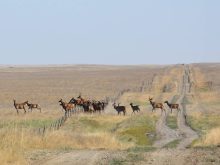BASF is developing products that will help pea growers contend with a devastating new root rot disease.
Aphanomyces was discovered in Saskatchewan fields in 2012 after growers complained of disappointing pea yields.
Testing confirmed the disease was once again prevalent last year.
There are no fungicides on the market to control it.
“We are actually going to be launching a new seed treatment that contains pyraclostrobin and xenium, so it’s very close to Priaxor, in hopefully 2016, and that’s one of the diseases we’re looking at,” Russell Trischuk, technical marketing specialist with BASF Canada, said during a recent Saskatoon stop on the company’s Knowledge Harvest tour.
Read Also

Bunge’s crop mix is changing
Bunge has predominantly been a soybean processing firm, but that’s about to change after the merger with Viterra with softseed processing and grain merchandising gaining ground.
“We have got a few other projects on the go that we can’t talk about for probably a year or two that may help with (aphanomyces).”
That is music to the ears of Sabine Banniza, professor of plant pathology with the University of Saskatchewan’s Crop Development Centre.
“If there is some new chemistry by BASF, that would definitely be very nice because currently nothing works,” she said.
Banniza and researchers from Sask-atchewan Agriculture and Agriculture Canada collected and analyzed samples from pea and lentil growers complaining of significant root rot problems last year.
They found various fusarium species in the roots and later confirmed the presence of aphanomyces. The disease has been found from northwestern Saskatchewan to Assiniboia to Yorkton.
“That suggests to us that the pathogen is probably most likely everywhere and probably has been there for many, many years,” said Banniza.
“This aphanomyces pathogen specifically is a pathogen that really, really thrives in wet, soggy soils, and that’s exactly what we have had in the last three or four years.”
Denis Gregoire, president of Gregoire Seed Farms Ltd., said the disease showed up in one of his green pea fields near North Battleford, Sask. He believes it thrives in heavy, black soil under high moisture conditions.
“In this one particular field we had two inches of rain on one Sunday, and that did it,” said Gregoire.
Aphanomyces can have a devastating impact on yields. The high spots of Gregoire’s infected field generated pea yields of 45 bushels per acre.
“We got into this area and we were surprised we were even picking up 28 bu. an acre,” he said.
The disease can attack peas, lentils and other legumes at any stage in the growth cycle. It can decimate yields if it hits before or during seed setting.
Banniza said the only control option is to avoid planting legumes for eight to 10 years on a field where the disease is suspected.
Growers in southern Saskatchewan may get away with planting chickpeas because that crop has partial resistance to aphanomyces.
“I have been asked what happens if we have two years of drought,” she said.
“I don’t know. Maybe that sort of results in an implosion of the pathogen population and you can go back to that field earlier, but I don’t think there is any scientific data on that.”
The CDC has a pure culture of aphanomyces that it will make available to seed testing labs in hopes they will develop a screening test for growers.
Pea breeder Tom Warkentin will be using the culture to develop aphanomyces resistant lines of peas.
Banniza said a large root rot re-search project led by Agriculture Canada received funding last summer, which should help develop better tools for combating the disease.
















